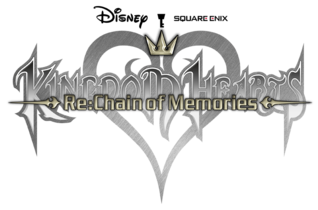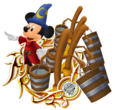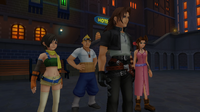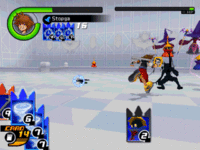Kingdom Hearts Re:Chain of Memories
Oh no! The water! I'm in big trouble if I don't fetch it!
| |
| This article requires cleanup or improvement.
Please help out by editing this page. Please see the Manual of Style and editing help before getting started. Issues: See Kingdom Hearts Final Mix#Changes | |
| Kingdom Hearts Re:Chain of Memories | |
|---|---|

| |
| キングダム ハーツ Re:チェイン オブ メモリーズ Kingudamu Hātsu Re: Chein obu Memorīzu | |
| Developer(s) | Square Enix |
| Publisher(s) | Square Enix |
| Release date(s) | |
| Genre | Action role-playing game |
| Game modes | Single player |
| Ratings | CERO:A ESRB: E10+ |
| Platform(s) | PlayStation 2 |
- "Memory is the key."
- —Tagline
Kingdom Hearts Re:Chain of Memories is a full remake of Kingdom Hearts Chain of Memories, released on the PlayStation 2. In Japan, it is part of the Kingdom Hearts II Final Mix+ compilation and has connectivity features with Kingdom Hearts II Final Mix. As there were no plans to release Kingdom Hearts II Final Mix internationally, these features were modified for the North American release.
The game was remastered in HD and released as part of Kingdom Hearts HD 1.5 ReMIX for the PlayStation 3. This edition of the game further alters the previous connectivity bonuses by instead allowing additional content from watching the collection's scenes from Kingdom Hearts 358/2 Days. It was later released as part of Kingdom Hearts HD 1.5 + 2.5 ReMIX.
Development[edit]
Due to the original Game Boy Advance release being on a different platform than the other mainline games and selling worse than the first game, many Kingdom Hearts fans skipped that entry and waited until Kingdom Hearts II. This caused issues with the coherency of this next game, as playing Chain of Memories was crucial to understand the plot. The opening movie of Kingdom Hearts II offered a very brief recap of the previous two games, but many were still met with confusion over the plot of the game. Due to these complaints, a remake of this game was decided to be made for PlayStation 2 so the entire series would be on one system.
Kingdom Hearts Re:Chain of Memories was a total redesign of the game into a three-dimensional computer-rendered game for the PlayStation 2, in the same style as the other released entries in the series, Kingdom Hearts and Kingdom Hearts II. This revamp included changing the battle arenas from two dimensional screens without "height" into full three-dimensional arenas, allowing enemies to rise out of the player's range.
Additionally, these arenas can be aesthetically varied, even within the same world, while in the original game there was only one arena design per world. The "Duel" system was added to Riku's battle mechanics, and the Reaction Command system of Kingdom Hearts II was incorporated into both Sora and Riku's battle mechanics, generally to replace instances where the player would press the "A" button to continue a combo attack.
The game now has fully voice-acted full motion videos and the use of voice-acting within gameplay. While the dialogue for the game was recorded using the voice actors used in Kingdom Hearts II, the voicing and sound effects within gameplay relied largely on existing clips. In some cases, such as the Sora's invocation of the Stop spell, these clips were only available using the Kingdom Hearts voice-actors. As the scenes were now fully rendered, rather than being acted out with sprites, the violence within the game was more apparent, and the game's rating was raised from E to E10+, for Fantasy Violence.
The game's card system and overall plot remained the same as the original Kingdom Hearts Chain of Memories, and "Simple and Clean" is the game's theme song. However, there were many small tweaks to the storyline, as well as the addition of new Cards, Sleights, bosses, and a Theater Mode to re-watch the game's full-motion videos.
Quick Save option and Link Mode had been removed.
Changes[edit]
New features[edit]
Features[edit]
- Sora can now collect Moogle Points during battle.
- New Sleights: Magnet Spiral, Lethal Frame, Freeze, Firaga Burst, Raging Storm, Stardust Blitz, Goofy Tornado Lv2, Goofy Smash, Wild Crush, Furious Volley, and Lucky Bounty.
- Removed Sleights: Gravity Raid, Stop Raid, Homing Fira, Firaga Break, Blazing Donald, Goofy Charge, and Ferocious Lunge
- New cards:
- Keyblades: Hidden Dragon, Follow the Wind, Monochrome, Photon Debugger, Bond of Flame, and Star Seeker.
- In Kingdom Hearts HD 1.5 Remix, the first four of the Keyblades listed above were replaced with Maverick Flare, Midnight Roar, Total Eclipse, and Two Become One, respectively.
- Enemy: Zexion, Saïx, Demyx, Roxas, Luxord, Xemnas, Xigbar, and Xaldin.
- Sora can no longer obtain the Darkball Enemy Card, due to its new effect revolving around Riku's newly introduced Card Duel system.
- Friend: Pluto
- Map: Bottomless Darkness, Roulette Room, and Random Joker
- Riku can now obtain the Black Room, Martial Waking, and Meeting Ground Map Cards.
- Special: Gold Card and Platinum Card.
- Keyblades: Hidden Dragon, Follow the Wind, Monochrome, Photon Debugger, Bond of Flame, and Star Seeker.
- The Journal now keeps track of minigame scores.
- The various color categories of map cards have a small symbol ("R", "B", "G", or "!") indicating their color.
- Theater Mode was added.
- Jiminy's Journal and the D-Report now includes journal entries on world cards. In addition, the D-Report also now includes entries on Map and Item cards.
- Riku's decks have been altered.
- Riku cannot level up his DP before he acquires Dark Mode from Ansem (unless he has obtained all HP bonuses).
- The music is updated to utilize the PlayStation 2's synthesizer, and three new tracks have been added: "Dash-A-Long", "March-A-Long", and "Lord of the Castle".
- The enemies that appear in the overworld are now more various.
Gameplay[edit]
- In the Japanese version, having a cleared Kingdom Hearts II Final Mix save file on the memory card will allow Sora to obtain a second set of treasures from the Room of Rewards on each floor, plus some extra Bounties on some floors.
- In the North American release, these were unlocked upon clearing Reverse/Rebirth.
- In Kingdom Hearts HD 1.5 Remix, these were unlocked upon watching the collection's scenes and viewing all Journal-based entries from Kingdom Hearts 358/2 Days.
- The High Jump, Glide, and Superglide support abilities are available for Sora.
- The Swing Speed stat for Sora's Attack Cards have been removed.
- The effects of several Sleights were modified such as Cloud's Omnislash, several of Sora's Keyblade Sleights (Blitz, Sonic Blade, Ars Arcanum), and several Friend Card sleights (Spiral Wave, Hummingbird) to where
 prompts appear in order for them to be fully used, akin to Reaction Commands.
prompts appear in order for them to be fully used, akin to Reaction Commands. - Many new props feature throughout the field, such as flowers in Wonderland which block doors and projectile-firing obstacles. They can inflict damage on the player character, inflict Confuse on them, cast Stop on enemies, or stun them depending on the prop.
- Props are no longer reset when re-entering the same room. The room needs to be recreated consequently.
- Due to this new feature, the first battle in Sora's Story will now take place before he uses his first Map Card as a result of the tutorial.
- Zantetsuken and Sonic Blade are now available to learn at levels 22 and 27 respectively (the reverse was true previously). Ars Arcanum, Tornado, Holy, Ragnarok, and Mega Flare are now available to learn at 5 levels higher than before at levels 37, 42, 47, 52, and 57, respectively, due to the new sleight Lethal Frame being learned at level 32.
- Riku's battle mechanics now include the Duel system and its Sleights, and now have the Holy Burst and Inverse Burst Friend Sleights.
- Due to the removal of Link Mode, the effect of the Darkball has been modified. In addition, as it is now designed to work with Riku's Duel system, it is no longer available in Sora's Story, and has been added to Riku's deck as a secondary regular Enemy Card for the Atlantica floor other than Sea Neon.
- Riku can use The King card in Destiny Islands and Twilight Town after the battle against Lexaeus.
- The Hidden Chamber which is accessed with the Key to Rewards card has been renamed as the Room of Rewards. In addition when viewed on the map, it is now counted as a special room instead of a regular room.
- A Room of Rewards has been added for the Castle Oblivion floor, unlike the original, which was the only floor that did not have a Hidden Chamber.
- The special rooms when viewed on the map now glow white to identify which one to open, making it easier to know which one to go to in worlds that use multiple Keycards. Also, when Sora has a Key to Rewards card in his possession, the Room of Rewards location is revealed by a blue glow.
- The attack and magic cards played by Axel, Larxene, Vexen, Marluxia, Lexaeus, Zexion, Captain Hook, Hades, Cloud, Ansem, and the Riku Replica depict different facial expressions, depending on their type.
- During his final battles with both Sora and Riku, the Riku Replica's left hand is immersed in an orb of darkness.
- When transforming into Dark Mode, Riku now says "Darkness" instead of simply screaming.
- The health bar the enemies use has been altered to resemble the one from Kingdom Hearts II.
- There have been changes in the musics.
- The piece "The 13th Floor", played outside of Worlds, is melodically different. Instead of handbells playing an ascending interval, chimes now play a descending interval.
- The piece "Go for It!" plays when Sora battles against Cloud, instead of "Face It", and the piece "Face It!" plays when Riku battles against Ursula, instead of "The Fight for my Friends".
- Level Ups now restore HP only if the HP Bonus is selected, instead of any bonus.
- Changes related to Prizes:
- All dropped prizes are automatically collected when any battle ends.
- The cards acquired from a boss battle only appear after the other prizes had been collected, as they now appear automatically to be grabbed.
- Experience prizes no longer vary in size, and are only differenciated by their blue, red, or grey appearances.
- Prizes no longer keep bouncing all over the area, and stay still after bouncing a few times before becoming collectable afterwards.
Battle[edit]
- While battling the Parasite Cage, the stomach acid will not inflict damage if Sora is reloading his deck.
- Several bosses that use sleights have new and/or removed sleights.
- Enemies have different stats compared to the original game.
- The final Marluxia battle has been split into two sub-battles. The first is generally the same as the original final battle, albeit on a standard circular arena instead of in a sub-space-esque field, while the second is set entirely on top of Marluxia's Specter, and features him as much more aggressive, with several powerful Sleights.
- Lexaeus can enter a temporary state of invulnerability and increased strength via his Charge technique.
- Ansem's first battle has been converted into a tutorial of Riku's new abilities (Rapid Break and Duel Sleights).
- Riku now confronts Zexion in a boss battle. During this battle, Zexion can steal Riku's cards, and Riku remains within Dark Mode for the duration of the fight.
- Bosses with vulnerability to stun remain stunned for much longer.
- If any regular hit from an Attack Card within a card stack gets blocked, the entire card stack is cancelled, wasting the subsequent cards of the stack.
- The player's deck now displays four cards instead of three, making the currently selected card, the second, and third cards visible for the player for sleights.
- Riku's decks in each world have been altered.
Storyline[edit]
- Flashbacks from the first Kingdom Hearts are included in cutscenes.
- The scene from Kingdom Hearts Final Mix that involves Sora fighting Xemnas as the Unknown is put into the opening cutscene.
- Axel finishes off Vexen by immolating him with a snap of his fingers.
- Goofy throws his shield at Larxene to temporarily distract her when she attacks Sora.
- When Sora was attacked by Larxene, Donald uses Curaga to heal him.
- On Floor 12, the Riku Replica is standing up and a Reaction Command triggers a cutscene and boss battle.
- During the climax of Sora's story, when Axel attempts to execute Marluxia for his betrayal, they have a brief fight before Marluxia uses Naminé as a shield. Marluxia also never leaves the room until the end of the fight.
- Riku is defeated and about to be destroyed by Lexaeus, using his final strength, only to be possessed by Ansem, Seeker of Darkness and defeat him.
- When Zexion's disguise as Sora is revealed, he directly battles Riku but is defeated and, fearful for his life, teleports away.
- After the Riku Replica's final defeat against Riku, he is swallowed by darkness.
- An extended scene of Roxas is shown along with Hayner, Pence, and Olette at the ending of the game.
- In the post-credit scene of Sora's Story, a scene of the Organization's unseen members is shown.
- When Axel first introduces himself to Sora, he says "Got it memorized?" as opposed to "Commit it to memory."
- Axel no longer says, "...give me a hell of a show!", as he did in Kingdom Hearts Chain of Memories. Instead, he says, "Try and make it enjoyable, Sora."
- In Larxene's first encounter with Sora, her "through" is misspelled as "though". This line is later fixed in the remake.
- DIZ on BF2 Exit Hall, giving Mickey and Riku their Organization cloaks and explaining its purpose.
Changes in worlds[edit]
- All worlds have additional rewards unlocked by completing Kingdom Hearts II Final Mix in the original Japanese release, completing both Sora and Riku's stories in the international release, or finishing the Kingdom Hearts 358/2 Days movie in Kingdom Hearts HD 1.5 ReMIX.
- Traverse Town changes:
- New Bounty available as a reward containing either Hidden Dragon or Maverick Flare[KH I.5 HD].
- Saïx's Enemy Card is available in the Room of Rewards.
- Olympus Coliseum Changes:
- Monochrome or Total Eclipse[KH I.5 HD] is available in the Room of Rewards.
- Agrabah changes:
- Warp is now available in the Agrabah Room of Rewards instead of Blazing Donald.
- Luxord's Enemy Card is available in the Room of Rewards.
- Wonderland changes:
- Monstro changes:
- Halloween Town changes:
- Jack Skellington's Friend Card is now available from the first battle in Halloween Town.
- Bind is now available in the Halloween Town Room of Rewards instead of Gravity Raid.
- Bond of Flame is available in the Room of Rewards.
- Sora, Donald and Goofy now wear their Halloween costumes while within Halloween Town. Riku and Mickey are also darkened and Mickey's card loses his smile.
- Atlantica changes:
- Neverland changes:
- Glide is now learned upon entering.
- Teleport is now the world's sole Bounty.
- Follow the Wind or Midnight Roar[KH I.5 HD] is available in the Room of Rewards.
- Hollow Bastion changes:
- Reflect Raid is now the world's sole Bounty.
- Xaldin's Enemy Card is available in the Room of Rewards.
- 100 Acre Wood changes:
- 100 Acre Wood has been modified to be a minigame world.
- Idyll Romp is now available as a reward for clearing Tigger's Jump-a-Thon.
- Cross-slash+ is now available as a reward for clearing Veggie Panic.
- Mega-Ether is now available as a reward for clearing Whirlwind Plunge.
- Elixir is now available as a reward for clearing Bumble-Rumble
- The new sleight Firaga Burst is now available as a reward for clearing Balloon Glider
- Spellbinder is now found in a chest in Tigger's Playground.
- Twilight Town changes:
- Warpinator is now a Twilight Town Bounty instead of Firaga Break.
- The new sleight Stardust Blitz replaces Warp in the Room of Rewards.
- Roxas's Enemy Card is available in the Room of Rewards.
- The Ansem, Seeker of Darkness card is now a Twilight Town Bounty instead of a Castle Oblivion one, becoming available after defeating Marluxia once and clearing Reverse/Rebirth.
- Destiny Islands changes:
- Zexion's Enemy Card is now available as a second Bounty after defeating Marluxia once and clearing Reverse/Rebirth.
- Photon Debugger or Two Become One[KH I.5 HD] is available in the Room of Rewards.
- Castle Oblivion changes:
- The new sleight Raging Storm is available as the world's first Bounty.
- A Room of Rewards has been added containing Super Glide.
- Star Seeker is available in the Room of Rewards.
- Other changes:
- Defeating Riku-Replica in the 8F Exit Hall yields the new sleight Magnet Spiral instead of Warpinator.
- Defeating Vexen in the 10F Exit Hall yields the new sleight Freeze instead of the Mega-Ether.
External links[edit]
| Kingdom Hearts HD 1.5 ReMIX |
|---|
| Kingdom Hearts Final Mix • Kingdom Hearts Re:Chain of Memories • Kingdom Hearts 358/2 Days |


